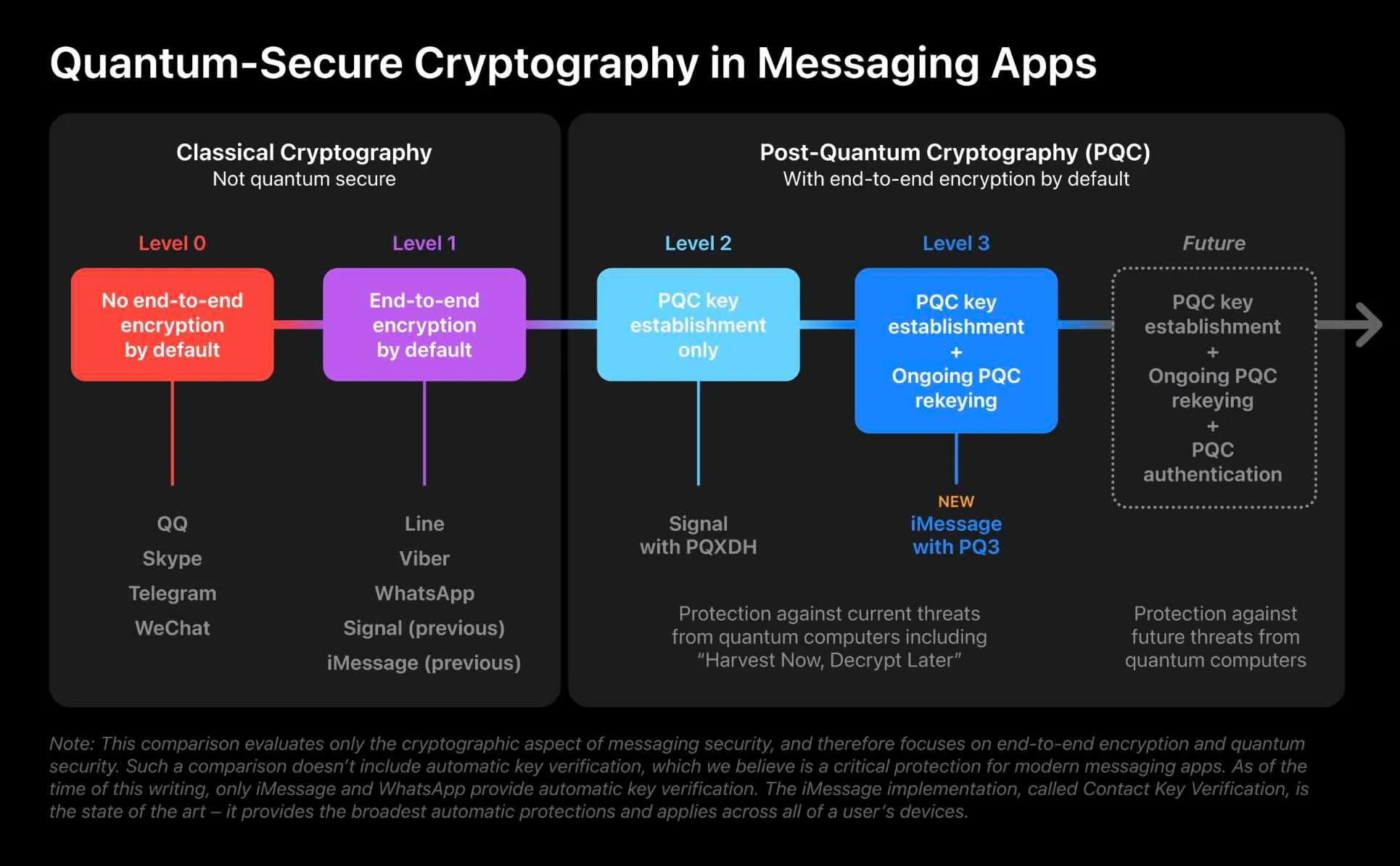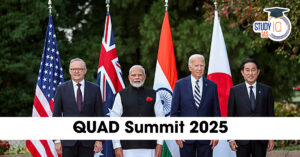Table of Contents
PQ3 Protocol
Context:
- Apple announced PQ3 (a post-quantum cryptographic protocol) to encrypt conversations in iMessage.
- Currently, Apple’s iMessage supports end-to-end encryption by default. This mode of protection relies on mathematical problems that could potentially be solved by powerful quantum computers.
PQ3: A Hybrid Approach
- Hybrid Design: PQ3 utilises a hybrid approach that integrates both traditional encryption methods (public and private key encryption) and post-quantum encryption.
- This is applied during the initial setup of communication between devices and also during the rekeying process, which periodically re-evaluates the cryptographic keys to maintain secure connections.
- Initial Key Establishment: At the start of a conversation, each device generates its own public keys.
- These keys are created locally on the device and are then sent to Apple’s servers as part of the registration process for iMessage, employing the Module Lattice-based Key Encapsulation Mechanism (ML-KEM).
- Post-Quantum Encryption Keys: When a sender wishes to send a message, the protocol enables the sender’s device to retrieve the recipient’s public keys from Apple’s servers.
- Using these public keys, the sender’s device can then generate post-quantum encryption keys specifically for securing the initial message.
- Periodic Rekeying Mechanism: The PQ3 protocol includes a mechanism for periodic rekeying within an ongoing conversation.
- This process is designed to reassess and renew the cryptographic keys between devices, ensuring that the security of the communication channel is continuously maintained.

Strengths and Limitations of the PQ3 Protocol
Strengths:
- Protection against current and future decryption: PQ3 combines traditional and post-quantum cryptography, offering enhanced security against decryption attempts, even by future powerful quantum computers.
- Reduced impact of key compromise: By limiting the number of decryptable messages with a single compromised key, PQ3 minimises the damage caused by such an event.
Limitations:
- Does not address group messaging: PQ3 is currently designed for one-to-one communication and doesn’t extend its security features to group chats.
- No authentication against quantum adversaries: While the protocol encrypts messages, it doesn’t guarantee the identity of the sender or protect against potential impersonation attempts by future quantum computers.
- No cryptographic deniability: PQ3 doesn’t provide a way for the sender to deny sending a message after the fact.
- Limited protection for messages stored in iCloud: The security offered by PQ3 might not apply to messages stored in iCloud backups, as their encryption method is not publicly known.
| What Is Cryptography? |
| Cryptography is a technique for securing information and communication using codes. It ensures that only authorised individuals can understand and access the information, preventing unauthorised access.
Tools and Techniques
Key Processes
Features of Cryptography:
Key Encapsulation Mechanism
|
GI Tag
Context: Cuttack Rupa Tarakasi (silver filigree) has been given the Geographical Indication (GI) tag by the Geographical Indications Registry in Chennai.
Other Products With GI Tag
- The other products to join the GI league are Banglar Muslin, one of the popular traditional handloom crafts of Bengal; Narasapur crochet lace products; and Kutch rogan craft.
- Ratlam Riyawan Lahsun (Garlic), a variety named after Riyawan village in Ratlam district of Madhya Pradesh, also bagged the GI tag along with the Ambaji White Marble, which is formed when limestone is re-crystallised under the earth’s crust due to intense pressure and heat.
- Tripura Risa Textile, Hyderabad Lac Bangles, Majuli Mask of Assam and the Assam Majuli Manuscript Painting are other products that got GI tag.
About GI Tags
- About: GIs are labels indicating the origin of a product from a specific geographical location, region, or country. They signify quality and uniqueness linked to the product’s place of origin.
- GI Tag in India: In India, the Department for Promotion of Industry and Internal Trade, under the Ministry of Commerce and Industry, is responsible for awarding GIs.
- Legal Framework And Obligations: Under Articles 1 (2) and 10 of the Paris Convention for the Protection of Industrial Property, geographical indications are covered as an element of IPRs.
- It is also covered under the Trade Related Aspects of Intellectual Property Rights (TRIPS) Agreement of WTO.
- Validity: This tag is valid for a period of 10 years following which it can be renewed.
- Significance:
- The Geographical Indications of Goods (Registration and Protection) Act, 1999, protects against the unauthorised use of a GI tag. Unapproved traders using the GI tag can face legal action.
- Prevents unauthorised use of GI tag products by others.
- It helps consumers to get quality products of desired traits and is assured of authenticity.
- Promotes the economic prosperity of producers of GI tag goods by enhancing their demand in national and international markets.
We’re now on WhatsApp. Click to Join
OPEC+
Context: Several members of the oil producer group OPEC+, including Moscow and Riyadh, have agreed to extend the production cuts they initially implemented in 2023.
Organization of the Oil Exporting Countries (OPEC)
Formation and Growth
- Founded in 1960 in Baghdad by Iran, Iraq, Kuwait, Saudi Arabia, and Venezuela in response to oil companies’ dominance.
- Aim: Coordinating petroleum policies and securing fair and stable prices.
- OPEC is a permanent intergovernmental organisation of 12 oil-exporting developing nations
| Angola: Became an OPEC member in 2007 and withdrew its membership effective January 1, 2024. |
- Headquarters: Vienna, Austria.
- Membership: Membership has seen changes over time due to economic and political factors.
- New members must be approved by a three-fourths majority of existing members, including all founding members.
- Objectives and Functions
- Coordinates petroleum policies to stabilise markets.
- Sets production quotas to balance supply and demand.
- Conducts biannual market reviews to inform policy decisions.
OPEC+ Alliance
- OPEC+ united OPEC with 10 non-member nations, led by Russia and Saudi Arabia.
- Non-OPEC participants include Azerbaijan, Bahrain, Brunei, Kazakhstan, Malaysia, Mexico, Oman, Russia, South Sudan, and Sudan.
- OPEC+ represents around 40% of world oil production and its main objective is to regulate the supply of oil to the world market.
| Facts
79.5% (1,243.52 billion barrels) of the world’s proven oil reserves are located in OPEC Member Countries, with the bulk of OPEC oil reserves in the Middle East, amounting to 67.2% of the OPEC total. |
WTO MC13
Context: The 13th Ministerial Conference (MC13) of the World Trade Organization (WTO) concluded without significant progress, leaving key issues unresolved. Here’s a breakdown of the outcomes and implications for India:
Agriculture
- What India wanted: India sought a ‘permanent solution’ to the public stockholding issue, crucial for domestic food security.
- Outcome: No agreement was reached due to differences among countries, particularly regarding the potential impact on other nations’ food security.
- Implications for India: India is shielded by the ‘peace clause’ for now, but the lack of progress is concerning for global food security and millions of farmers’ livelihoods.
Fisheries Subsidies
- What India wanted: India aimed to address harmful subsidies while safeguarding the livelihoods of small-scale fishers.
- Outcome: No specific outcome or mention of fisheries subsidies in the ministerial declaration.
- Implications for India: India maintains policy space, but negotiations pose ongoing threats to small-scale fishers’ livelihoods.
E-Commerce
- What India wanted: India opposed the continued exemption of Customs duties on e-commerce, citing adverse effects on revenue.
- Outcome: WTO agreed to extend the moratorium on Customs duties until the next ministerial conference or March 31, 2026.
- Implications for India: Disappointment expressed over lost tax revenue and constrained policy space for digital industrialization.
Other key outcomes and Issues
- Investment Promotion for Development: India and South Africa blocked a pact led by China, opposing plurilateral agreements fearing a dilution of the multilateral trade framework.
- New Issues: Concerns raised about emerging issues like e-commerce, investment, and MSMEs entering the WTO agenda.
- Moratorium Extension: A last-minute agreement extended the moratorium on tariffs for digital trade by two years, providing a small victory amidst minimal consensus.
- Reforms and Engagement: The declaration signaled a commitment to continue working on essential reforms for the WTO’s functioning. Commerce Minister Piyush Goyal emphasized the need for repairing basic functions like the dispute settlement system before expanding the scope of agreements.
- Dispute Settlement Mechanism: The impasse in appointing new judges to the appellate body, crucial for resolving trade disputes, persists. The Biden administration’s lack of engagement has contributed to this issue, hindering the WTO’s progress.
- Plurilateral Agreements: MC13 addressed various agreements, including services regulation and investment facilitation.
While India’s efforts to address key issues in the WTO are commendable, it must balance its priorities with the need to prevent prolonged breakdowns in the multilateral system. Forming coalitions with other developing countries could strengthen India’s position and advocate for sensible trade policies on the global stage.
Examples and Case Studies for Value addition
- Community initiative, Women Empowerment (GS1, GS2) : Women in Karnataka, handle end-to-end waste management in gram panchayats, including collection and driving of the ‘Swachh’ vehicles, providing them with employment and empowerment, as well as improving the sanitation and environment of the villages. This demonstrates the potential and role of the local communities in addressing the social and ecological challenges and creating positive change.
- Ethics, Compassion (GS4): Ruth Gottesman, who inherited a fortune from her husband’s investment in Berkshire Hathaway. donated $1 billion to a medical school, to cover the tuition of every student


 SSC MTS Salary 2025, Check Highest Salar...
SSC MTS Salary 2025, Check Highest Salar...
 F-35 Fighter Jet Stranded in Kerala: Dis...
F-35 Fighter Jet Stranded in Kerala: Dis...
 Quad Summit 2025: Key Announcements, Str...
Quad Summit 2025: Key Announcements, Str...





















